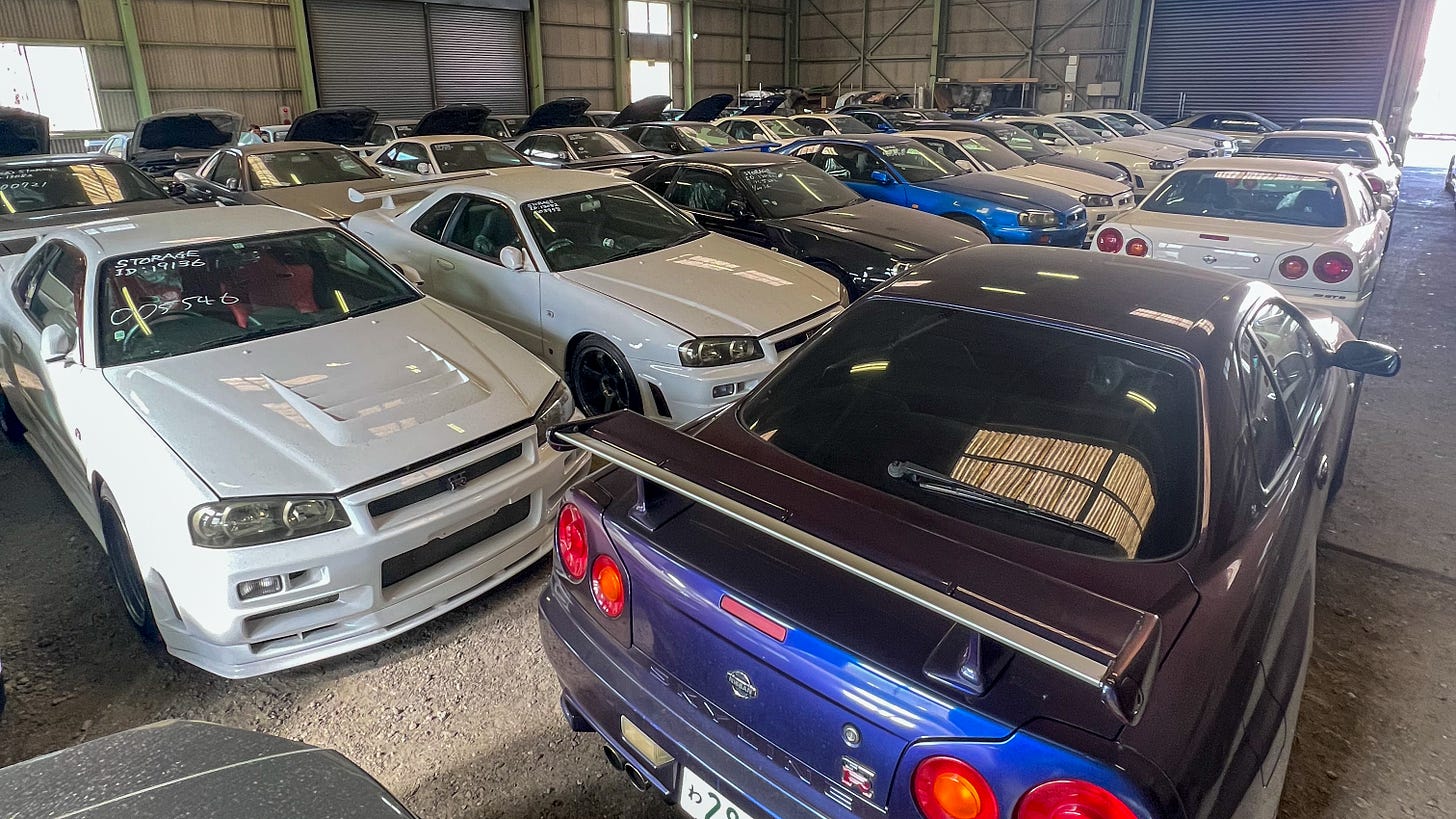Book Excerpt: Cult of GT-R, Chapter 1
How and why the book kicks off with a secret Japanese bunker
Welcome to the first of our weekly installments with excerpts from Cult of GT-R, my newest nonfiction book about the history and controversy of the Nissan Skyline GT-R, available now. Every Monday, I’ll post a short section from a different chapter, plus photos and commentary, to give you a taste of what’s in the book. Let’s kick things off now with Chapter 1. To buy Cult of GT-R, click here for my website or find it at your favorite online retailer.
FOLLOW THE MAN with the keys, I was told. He pushed a small metal dolly, the size of a mini-fridge, with tiny grocery cart wheels that rattled over bumps and cracks in the pavement. I skipped nonchalantly to keep pace, but inside my stomach was leaping with excitement. The cart’s bottom shelf held oil jugs, jumper cables, and tackle boxes. Bright blue tackle boxes, full of keys. With each tiny crack along the way, the keys clanked and jangled around inside. I had traveled thousands of miles to see what they could unlock.
My hosts asked me, politely, not to photograph the man, his cart, or the building. Not that the building itself is that interesting — located 20 miles outside of Tokyo, the structure goes unnoticed by thousands every day. But inside it held treasures that, to some, are worth spending a life pursuing. My guide and I followed closely as the man and his cart moved noisily across the lot. It was a slightly awkward, low-tech parade toward something so hallowed. I had to laugh.
When we reached the structure, the man with the cart stopped by a large roll-up door. He removed the massive padlock holding the door in place, then pressed a button on the wall.
As the door lifted, midday sunlight inched across the ground, creeping into the room and exploring all its corners and walls. My guide and I ducked underneath the door and stepped into the cavernous space beyond, eyes slowly adjusting to the darkness and the hoard within. Rows and rows of forbidden Japanese sports cars. Everywhere the eye could see.
I stood frozen. Inside the hangar-sized space, with its gray walls and aged steel support beams, the building could easily have passed for a Soviet-era bomb shelter. The cars consumed it. There were at least 60 of them, parked side-by-side in rows of 10, with scarcely enough room to squeeze sideways between them. Stragglers nestled neatly in the corners or wedged into whatever small pockets of open space could be managed.
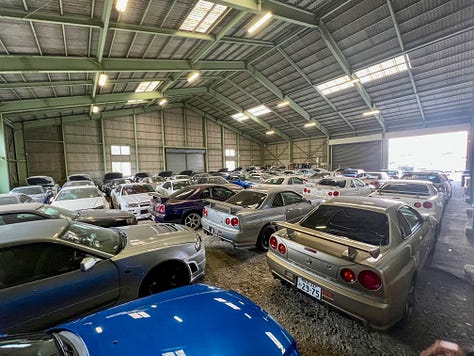
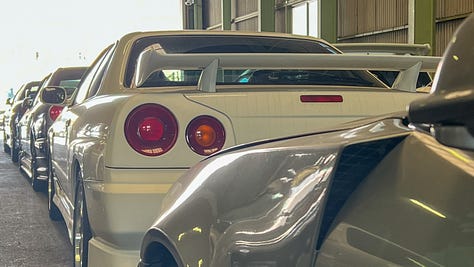
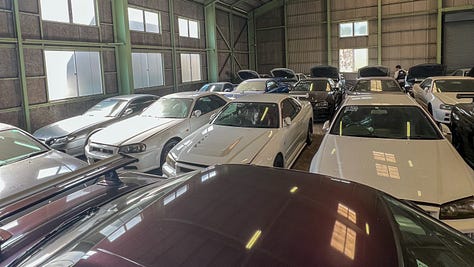
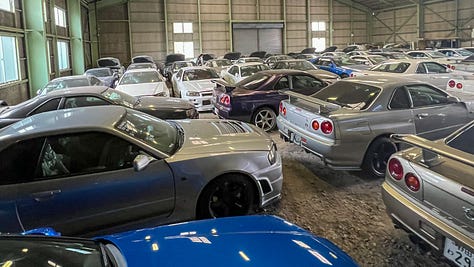
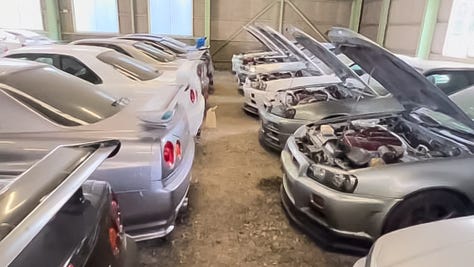
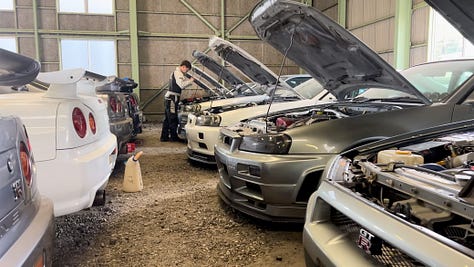
Nearly all of them were Skyline GT-Rs — the R34 version, to be exact. Today, it’s the rarest and most coveted of the trio. Built for the Japanese market, each one was right-hand drive with a manual transmission. The R34 GT-R is unmistakable with its boxy body, gaping bumper intakes, and enormous rear spoiler. Stare at it from the rear and a pair of comically large, perfect-circle dual taillights will stare right back.
The first two versions of the Skyline GT-R, the R32 and R33, are now more than 25 years old. As a result, they’ve been eligible to legally import into the US for years. But when I visited the secret storage warehouse, that time had not yet come for the R34. It’s incredibly rare to see one in America. They are the forbidden fruit of the car world. There, laid at my feet and basking in the Japanese dusk, were dozens.
"It’s a jaw-dropping moment," my host whispered. "You know how much these cars cost."
All told, the warehouse probably held $10 million in GT-Rs. Every one of them had already been bought and paid for, the vast majority by American customers. Since they were unable to take delivery at home due to the 25-year rule — at the time of my visit, the closest R34s were still almost a year from that milestone — the cars’ owners had paid to keep them stored safely in Japan. One GT-R had been kept in that building for seven years.
Some buyers made special trips across the Pacific to "visit" their cars, journeying to the warehouse as if it were the Louvre. Others had been waiting years to bring home a six-figure object they had only seen in photographs. All of them were paying hundreds of dollars in rent each month to store a vehicle an ocean away, and when those machines eventually came of age and got shipped off to America, there were more parked outside, waiting to take their place.
GT-R OWNERS aren’t turned off by the fact that the car they love is difficult to acquire and own. On the contrary, they live for it. They are consumed by it. The lengths to which they will go, I would come to learn, are often fanatical. The rewards they seek can appear meager, the risk astronomical. This is, after all, a Nissan. People have smuggled GT-Rs into the U.S. by gambling their careers, their life savings, and even their freedom.
This was the world I wanted to explore. The journey would take me from the gray and black markets of Los Angeles to 19th-century Japan, the roots of illegal street racing in Tokyo, and back to L.A. again. Over ten months of research, interviews, and travel, I examined hundreds of GT-Rs and met countless owners. Each of those people had a version of the dream that was different and unique. More often than not, those dreams had just one thing in common — the dreamer was determined to make them come true.
And when it comes to making your GT-R dream a reality, and doing it the right way, most everyone agrees that there’s only one person to call.
About this Chapter
My first draft of Cult of GT-R had a completely different opening. Originally I wanted to start with the story of the Miami couple who were busted for forging titles on hundreds of imported Japanese sports cars, outlining the seriousness of their charges, and the depths of the passion (some may say madness) that exists in this world. The problem was they were practically ghosts — aside from some stories about their initial arrest, they seemingly erased all traces of themselves online, and my public records requests for court files hadn’t come in yet.
So after talking it over with my editor, we agreed the next most compelling option for the opening scene was the very first place I visited in Japan — the Toprank warehouse where U.S. owners stash their cars while they wait for them to become legal. This would introduce readers to the car, to my travels through Japan, and to the complicated web of regulations and laws that have kept the Skyline GT-R out of the U.S for the past 25 years.
My worry was that I wanted the book to be about people, and that starting with the car wouldn’t grab general interest readers like a good character can. But I came to see that whether I liked it or not, the Skyline GT-R is a character in itself, with its own gravity and plotlines and pitfalls. In the end, the story had to start with that warehouse. The one that held all my main characters.
Link Central
To close things out, here’s a collection of stories I’ve found interesting lately:
The World's Fastest Road Cars — And The People Who Drive Them (The New Yorker)
DAMD Brings Rally Styling to Suzuki Jimny for 2024 Tokyo Auto Salon (Car And Driver)
Barrett-Jackson’s Future Collector Show Returns to Scottsdale (Barrett-Jackson)
Happy New Year!
Check out Carrara Media on Instagram, Twitter and Facebook and visit our store to order one of our many fine books and eBooks.




